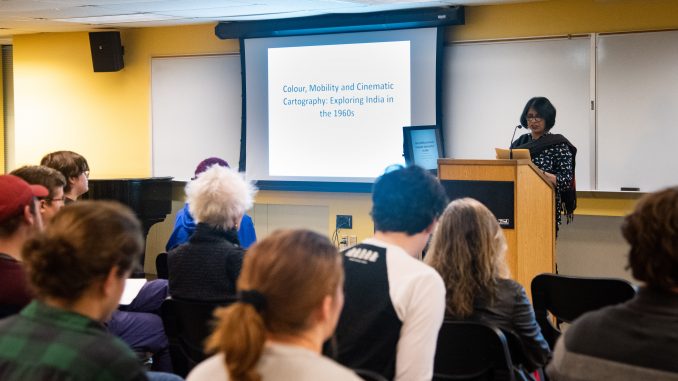
Color was a late addition to Bollywood, said Ranjani Mazumdar, professor at the School of Arts and Aesthetics at the Jawaharlal Nehru University, New Delhi.
The addition of color came with the industrialization of India that followed its 1947 independence from the British, she added.
Mazumdar spoke to students at “Color, Mobility, and Cinematic Cartography,” an event about Indian film, and the impact that roadway infrastructure, automobiles and color had on the industry and the country in the 1960s at Temple’s Center City campus on Oct. 28.
She studied the topic for her book “Bombay Cinema: An Archive of the City,” because the time period is usually dismissed due to the lack of film plots. Developments in color and automobiles in film happened simultaneously in the time period, Mazumdar said.
Kartik Nair, assistant professor of film and media arts and Rahul Mukherjee, assistant professor of television and new media studies at the University of Pennsylvania, organized the event to help students learn about a film industry they may not hear much about in the United States, they said.
“Ranjani’s research delves into the question of how Bollywood made use of the changing Indian landscape, specifically the addition of many new highways,” Nair said. “Many of these dance sequences and song sequences are centered around the idea of highways.”
She said that the Nagpur Roadways Plan, a road system that linked villages from 1943 to 1963, was important because many of the films feature cars, especially the Willy’s MB Jeep.
This vehicle was introduced to India by car manufacturing company Mahindra & Mahindra and was influential in film, Mazumdar said.
“[It] was a popular choice for people to use and was aggressively advertised because of the rough terrain and lack of highways,” she said. “Vehicles are fetishized and serve an aesthetic purpose in film.”
The automobile presented a link between the untamed landscape of nature and the developed highways, which Mazumdar said were “two contrasting worlds in India at the time.”
She pointed out through various film clips the excitement of being on a highway surrounded by the unknown.
Gabrielle Lamb, a freshman film major, was excited to hear about socialism and industrialization sublime at the talk.
“We talked a lot about the picture, and I kind of wanted to get into the methodology creating a scene with culture, movement and color,” she added.
Matthew Olwell, a third-year MFA dance student, said that he was taking notes of film terms to expand his knowledge.
“I’m conscious of my ignorance in some ways, but I think there is definitely overlap in terms of, like, I look at a lot of historical footage in my own research for dance,” Olwell said
The idea that everyone was working as a collective to ensure a better tomorrow for India was another theme in Indian film at the time forced by Indian cinema to push the idea of a unified country under one culture, Mazumdar said.
“There is no such thing as Indian culture, but it was the first time Indians began to see India,” she added.



Be the first to comment